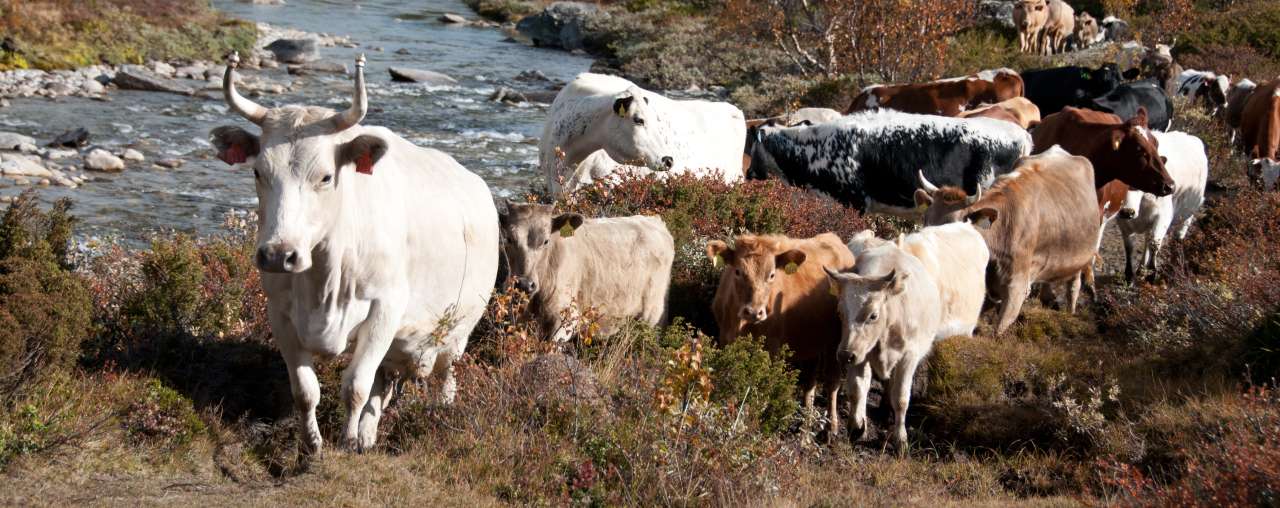
Farm animal genetic resources
Farm animal genetic resources in Norway include all farm animals used for breeding — whether they're the stray cat that has kittens in the backyard, the purebred dog that's inseminated with imported semen, the Dole horse mare that spends the summer in Sikkilsdalen, the ewe that mates with the prize ram, or the cow inseminated with elite semen. The production breeds owned by the breeding companies Geno, Norsvin and Norwegian Sheep and Goat Association are important genetic resources internationally, while endangered breeds native to Norway receive the most attention from national conservation programs in Norway.

The loss of farm animal genetic resources is a threat to food security nationally and globally. Using a small group of high-performing breeds for food production risks the loss of breed diversity and the genetic security it represents. All of Norway's native farm-animal breeds have an important role in conserving the breed diversity of farm animals globally.
Management of native farm animal genetic resources
Through its endorsement of the Convention on Biological Diversity, Norway has committed to the sustainable management of its biological diversity, including farm animal genetic resources. The Norwegian Genetic Resource Centre has an overarching responsibility for breeds native to Norway, and a particular responsibility for monitoring and supporting the endangered and critically endangered native breeds. The commercial breeding organizations Geno, Norsvin and Norwegian Sheep and Goat Association are responsible for the breeding programs for their respective non-endangered national breeds. These breeds are not included in the national conservation program. Norwegian Horse Association and the native horse breeding organizations are responsible for the conservation of their respective breeds.
The Norwegian Genetic Resource Centre develops, and is responsible for, the review of the national action plan for farm animal genetic resources.
Norwegian breeding
Norwegian breeding is primarily organized by cooperative enterprises, and is characterized by broad breeding targets for mixed breeds and a high level of adherence from active farmers.
In all breeding controlled by humans, it is vital that knowledge, planning, and execution ensure sustainable breeding. This means the animals' desired traits are improved (their production and exteriors), while avoiding inbreeding.
Publications
Authors
Nina SvartedalAbstract
No abstract has been registered
Abstract
No abstract has been registered
Authors
Cathrine Brekke Linn Fenne Groeneveld Theodorus Meuwissen Nina Svartedal Steffen Weigend Peer BergAbstract
No abstract has been registered
Authors
Nina Hovden Sæther Anna Caroline RehnbergAbstract
No abstract has been registered
Authors
Nina Hovden Sæther Anna Caroline RehnbergAbstract
No abstract has been registered
Abstract
No abstract has been registered
Authors
Nina Hovden SætherAbstract
This report presents all livestock production systems in Norway that significantly contribute to the country’s food and agricultural production. It describes the regulatory framework for Norwegian agriculture and aquaculture, as well as characteristics of the country’s production conditions and breeding work. The report discusses national expertise in the field of farm animal genetic resources and future developments regarding the country’s use of these resources. Furthermore, the report presents the conservation of Norway’s historical breeds with small populations. It concludes by making recommendations on which areas both Norway and the Nordic countries should emphasize regarding R&D activities and capacity building..... Genetic resource centre.
